No products in the cart.
Horse Care in Mongolia
Horse care in Mongolia looks back on a long history, whether its for herding, hunting, racing or war horses. For our wilderness expeditions in Mongolia, we work with our own herd of Mongolian horses, and their well being is of great concern to us at Stone Horse.
Professional Equines for Trail Riding Tours
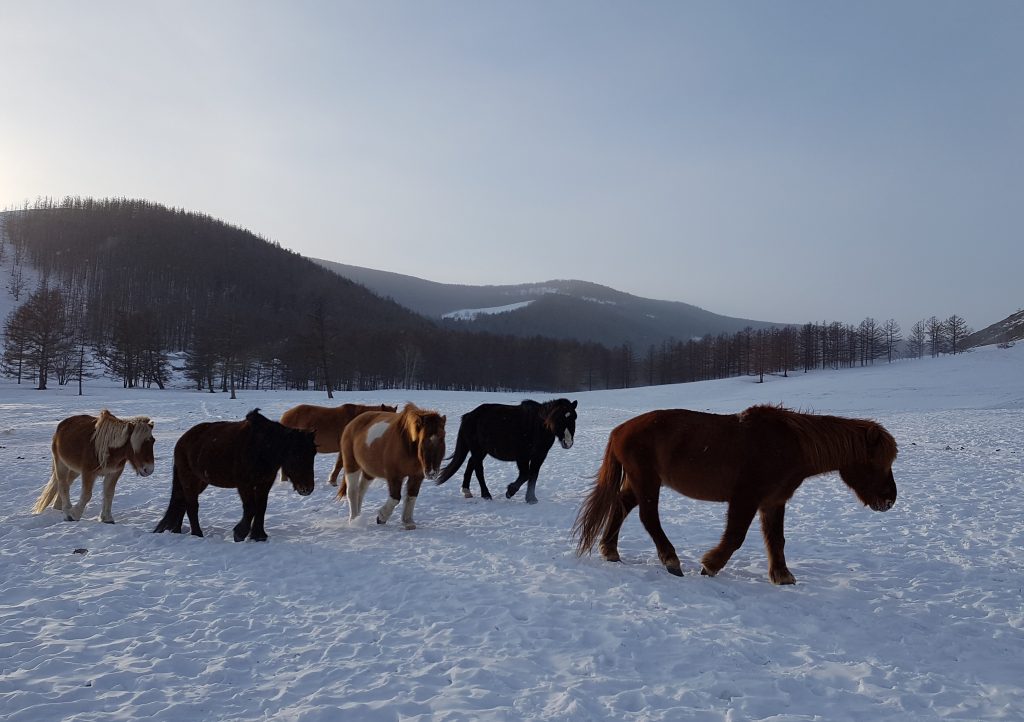
Relying on our own horses, as opposed to rental horses, for wilderness trekking in Mongolia is a hallmark of Stone Horse Expeditions. Knowing our equine team mates and their individual dispositions, abilities, experiences and talents is not only important for making horse riding tours safer. It adds much to the enjoyment of our trips, to the fun of being with horses, experiencing and appreciating them as sentient beings.
While Mongolian horses are extremely tough and self-sufficient, surviving in the harsh environment of their home country, a team of working horses still needs year-round horse care in Mongolia if they are to be ready for their job when the main riding season comes around in mid-June.
Winter Survival Experts
After the long Mongolian winter, spring is actually the most challenging time for livestock. Spring storms, with heavy snowfalls, can be disastrous for livestock that lost weight during the winter, and for their newborn offspring.
Mongolian horses have a great ability to paw in the snow, getting to the freeze dried grasses below. It’s a typical winter scene on the Mongolian steppes – large herds of horses grazing in the snow covered grasslands. And when there is no extreme weather event, it is a great way to bring horses through the winter. It bears risks of course, not only that of storms, but also predators, as well as rustlers.
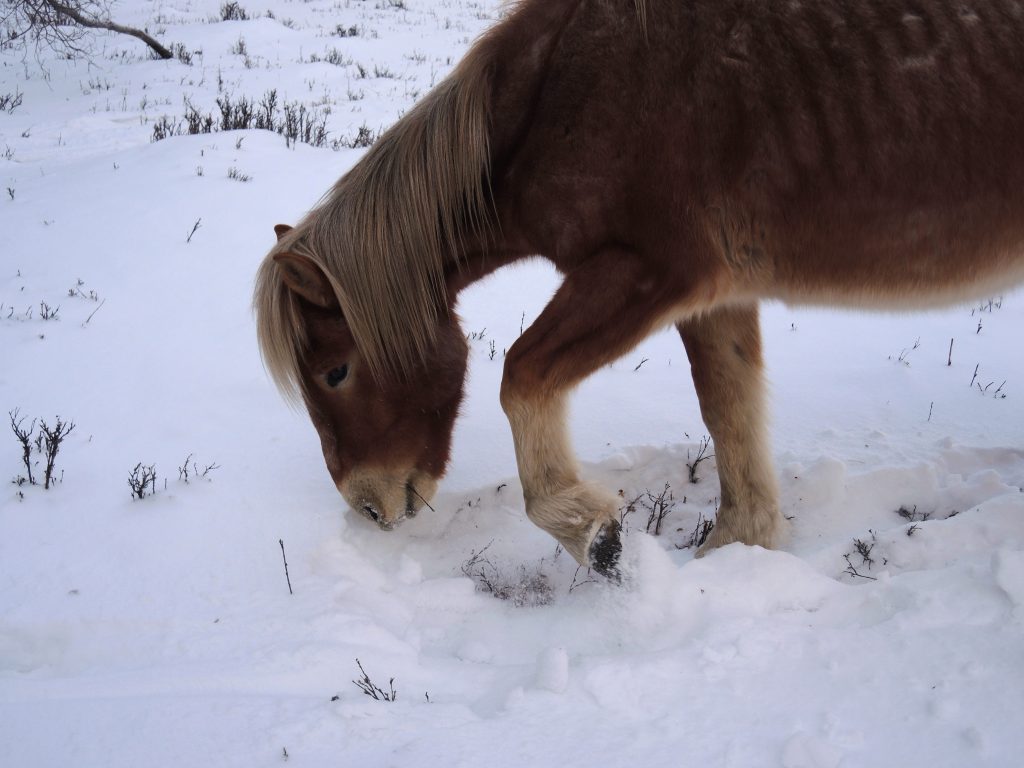
For horse owners who are not herding their horses themselves, it takes some preparation, as well as effort in spring time, to send their herd for winter grazing. Horses to be sent out to steppes, with another thousand or so equines, need to be branded before entrusting them to their winter care takers. In spring time, when they return from the grasslands, hundreds of miles away, they have to be found among the crowd, cut out and driven back to their summer home.
Winter Care for Stone Horses
In recent years, since our Stone Horse herd has grown ever larger, and with some distinguished members reaching their senior years, we have kept our horses in their home valley year round. For the day time, they go out for grazing. In the afternoon, they return to their corral, voluntarily and often early, knowing that hay for the night is waiting for them.
The corral also has a supply of salt, big chunks of rock salt which get formed into interesting shapes by the horse tongues – and those of other livestock that sneak in..
The hay is stacked up along the North side of their corral, and this is the only shelter they have all winter, in any weather. In a storm, when snow is drifting or blowing, and visibility is reduced, our herder will keep the horses in the fence for the day, feeding extra hay. Drifts of hard packed snow will built up during such days on the leeward sides of fencing. If too much, it needs to be removed as it is juts becoming a ramp for livestock to cross over the fence.
The horses have a very thick winter coat, and snow will just accumulate on their backs, such is the insulation of their winter fur. They actually look smaller now, in their fluffy outfits. They will weather winter storms, turning like wind vanes, with their rear ends facing the wind.
The morning routine on winter days consists of hay first, followed by equine muesli, a mix of oats and bran, served in sturdy bowls that are nested in old tires. There is an outer corral for the second course to make this as orderly as possible when feeding thirty hungry horses.
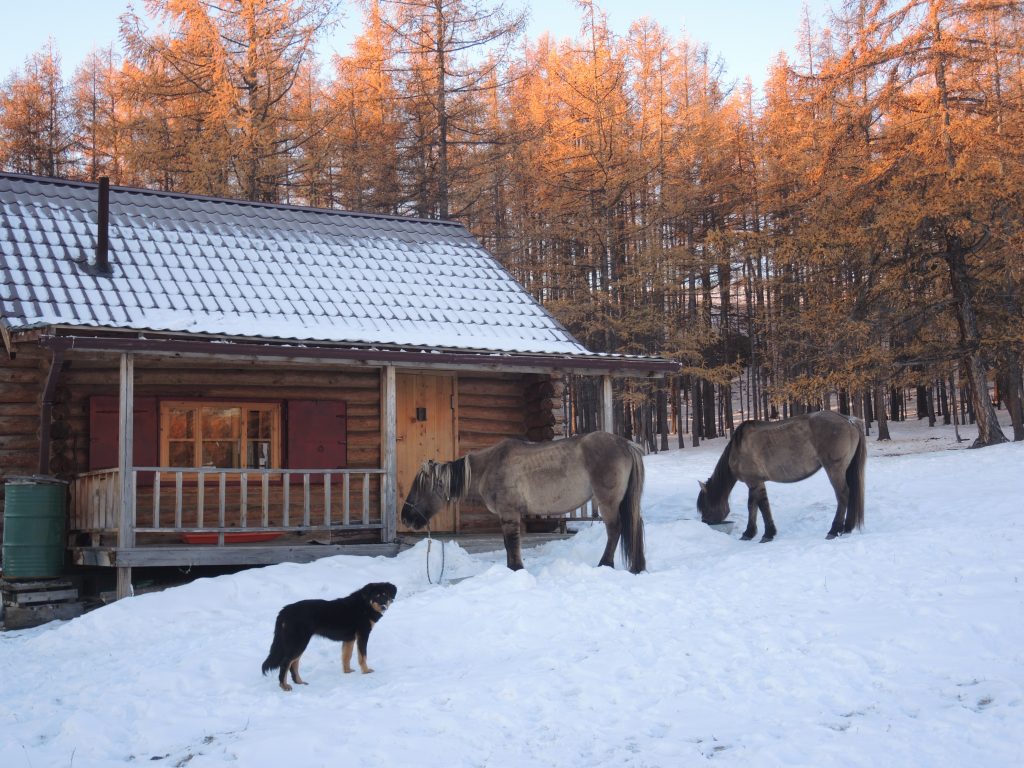
Once the hay is finished, the excitement about the imminent breakfast of oats increases rapidly. Some herd members will pace along the dividing fence, and become more and more vocal to express their eagerness, while their bowls are being filled from a large wheel barrow.
Once released into the breakfast corral, horses rush to a bowl and dig in, some will paw at the ground while feeding. When about halfway through their meals, some characters will begin to look at the neighbor’s bowl and inevitably come to the conclusion that it is fuller and should be theirs. That’s when a game of musical chairs begins that will last until every grain is finished. Some will be spilled in the process, and sparrows are waiting to feed on it.
The horses then head out, grazing in the valleys nearby. Their hoofs are important tools in winter to get to both food and water, and with their hoofs’ abilities, other livestock also benefit from grass being exposed and ice holes made. For their water needs, Mongolian horses will break holes in the ice of frozen creeks and ponds, and they will also nibble at the snow.
Getting ready for the Horse Trekking Season
Every season is a bit different, but usually April brings warm weather, with the first green showing up. There may be a dump of snow as late as May or even the first days of June though.. In April we pick a weekend with a good weather forecast for the big vet check of the Stone Horse equine team.
Grooming, and a Very Cool Haircut for Working Horses
Before the vets come, we begin with grooming so all the “boys” look a bit cleaned up already for the big day. Their winter coats will be shedding heavily, and a good brushing will produce bunches of hair. Not all will come out yet, but they already look much more summer – and saddle ready.
Having been handled too much during the winter months, some team members may have some thorny sticks and brush entangled in their manes.
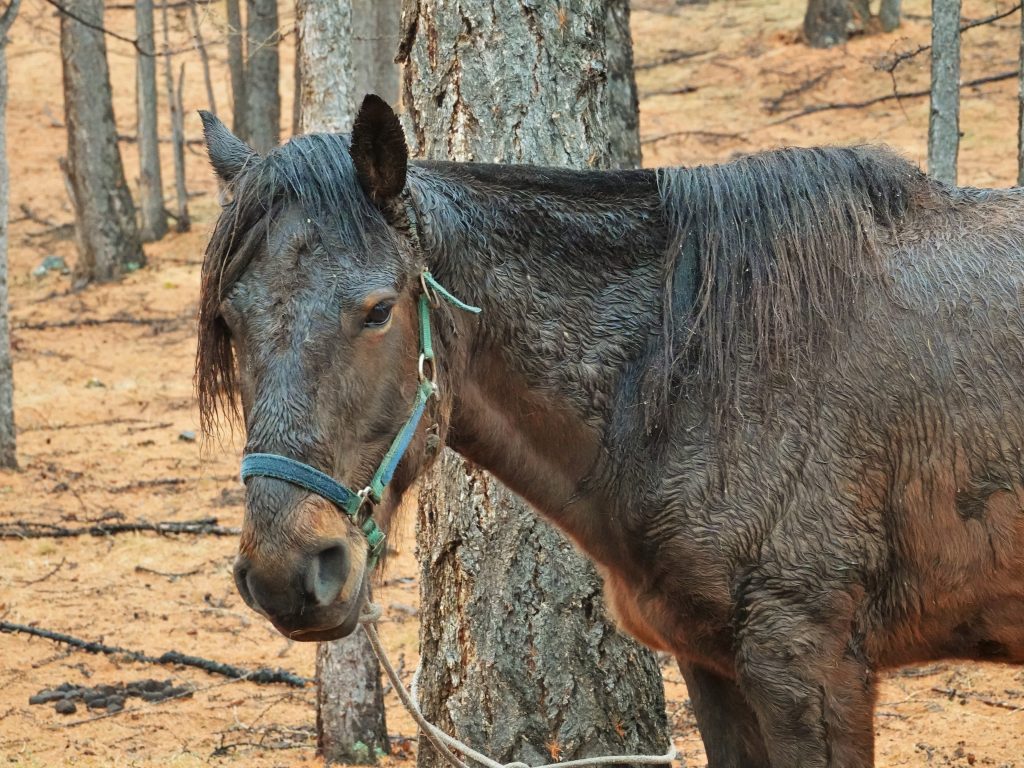
Some of the winter wild equines may be sporting dreadlocks in their long manes comes spring. All manes will benefit from a good brushing out, and entanglements are undone, or cut in some cases.
Then the majority of the herd members will receive their haircut, the style originating in one of the far Western provinces of Mongolia. It’s a cool style, leaving the forelock long of course, as the working trail horses need it to protect their eyes from insects. Then the upper portion of the mane is trimmed very short, and the lower part, to the withers, remains long.
Annual Veterinary Check for the Equine Expedition Team
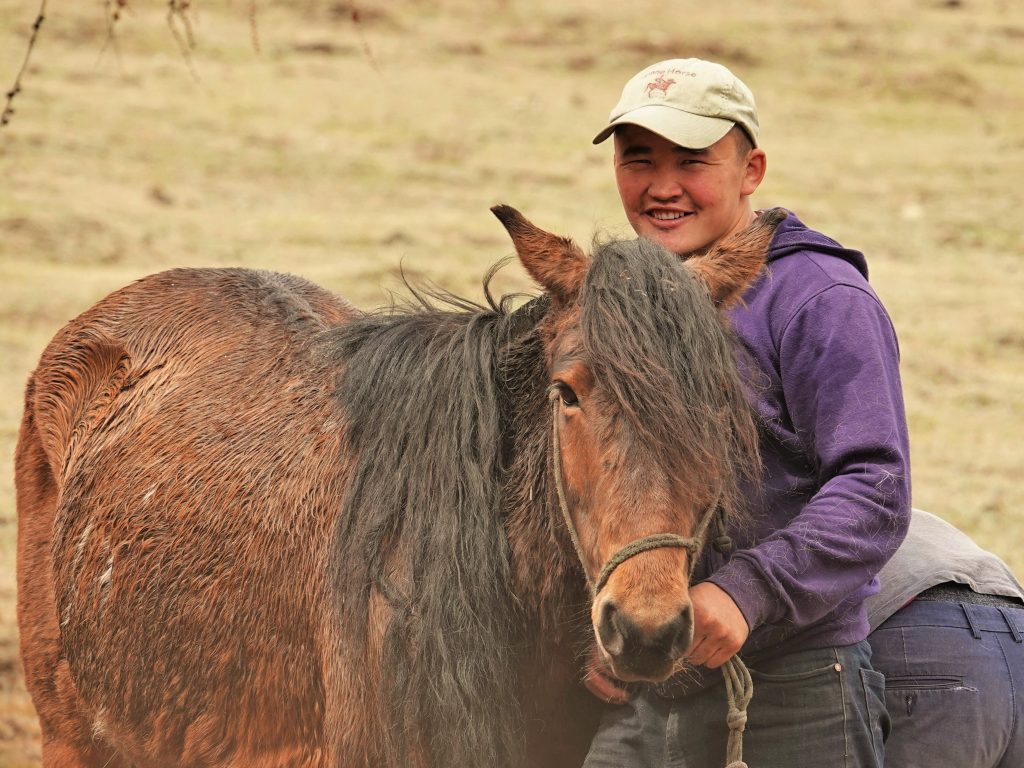
We have our “family doctors” for our equine team. Two Mongolian veterinarians, specialized in horses and with great experience and skills in diagnosing and handling horses, are the practitioners we turn to for house-calls as well as for the routine check-up.
The vet check day is a bit of a get-together with our whole team, human and equine, as well. The horses will know something is up when they are not released to pasture in the morning as usual, but brought over, five or six at a time, to the cabins and horse tack container, where the procedures take place.
The waiting room is the larch forest, and in the opening among the trees we begin the work. Two stations are set up, where the horses, one at a time, are lead to and hobbled Mongolian style – that is with both front feet and one back foot hobbled, normally the left rear.
The vets start with hoof clipping. The growth of hoofs will be quite varied among the horses. From pawing in the snow all winter, it’s not excessive in any of them. Some will hardly need a clipping, but normally a bit is needed. At the end of the day, the clippings of some thirty horses will be scattered all over the ground around the treatment area.
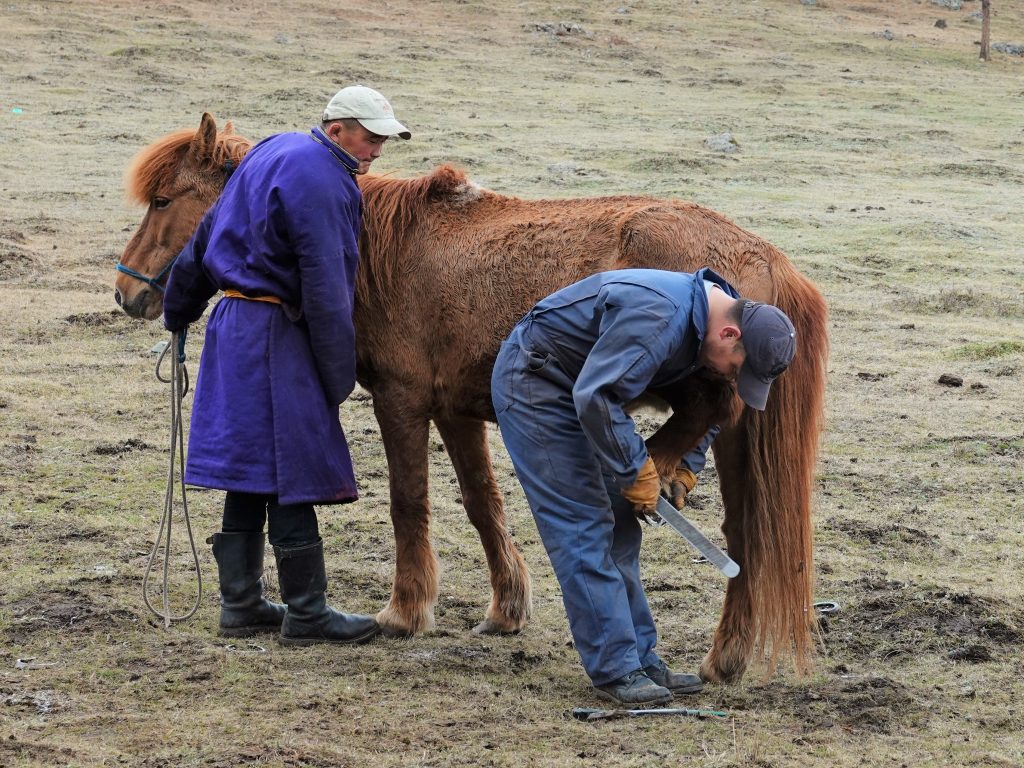
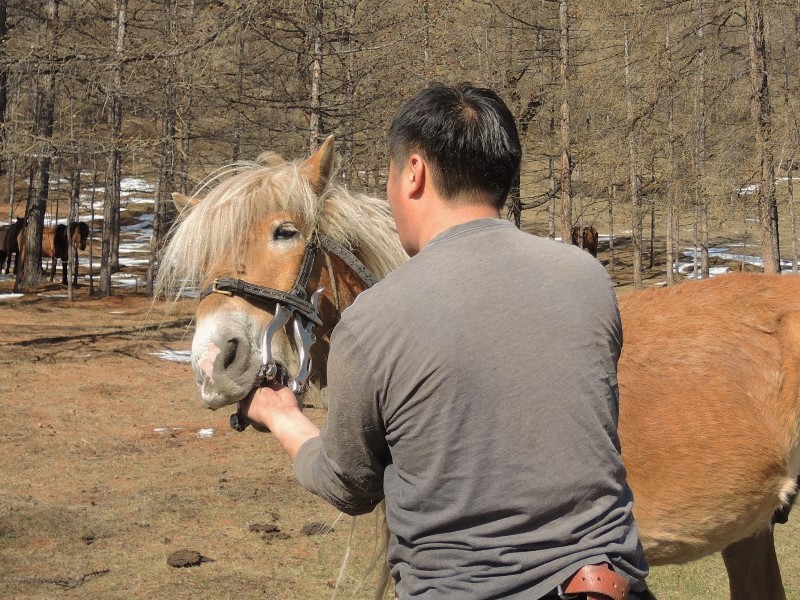
Next is the dental check, and if needed, floating the teeth. I am always surprised that most of the horses take this relatively calm. It sounds pretty bad, and must feel uncomfortable but most of them are fine with it. There are, however, some characters that do not settle down for teeth floating and also are quite fuzzy about the hoof clipping. And the difficult ones may not necessarily be the ones that are the more spirited ones as riding horses on the trail. So we usually have two or three candidates that will get a shot to calm them down a bit for the check-up.
After the dental work, a vitamin shot is administered into the neck muscles, something most of them hardly register as the skilled vets do their job.
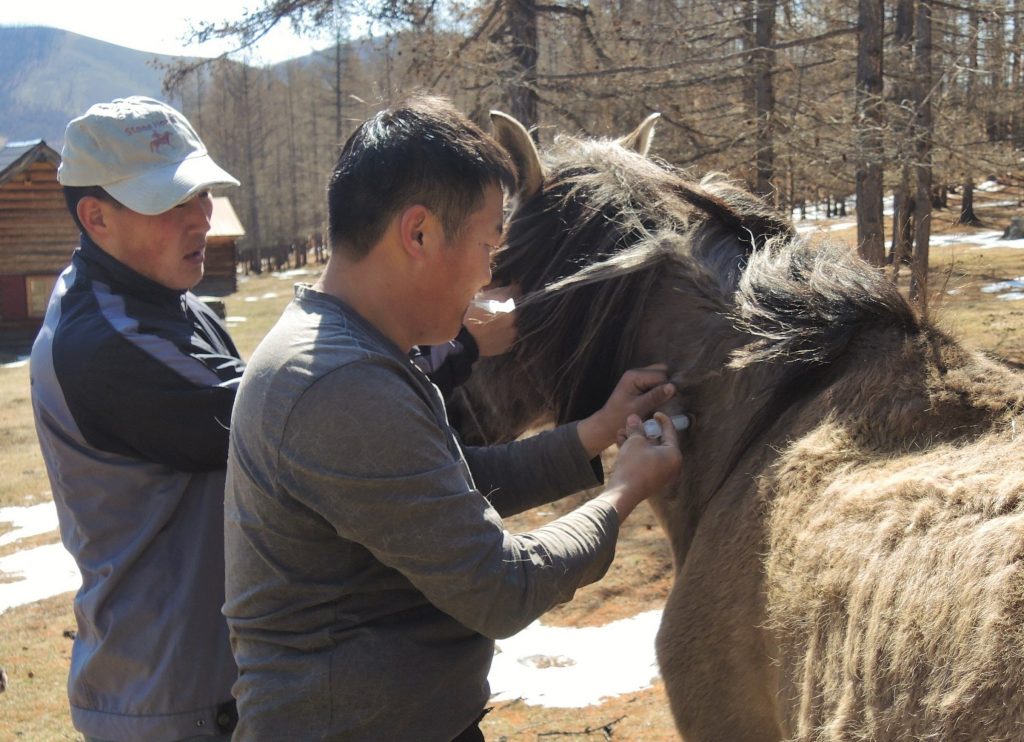
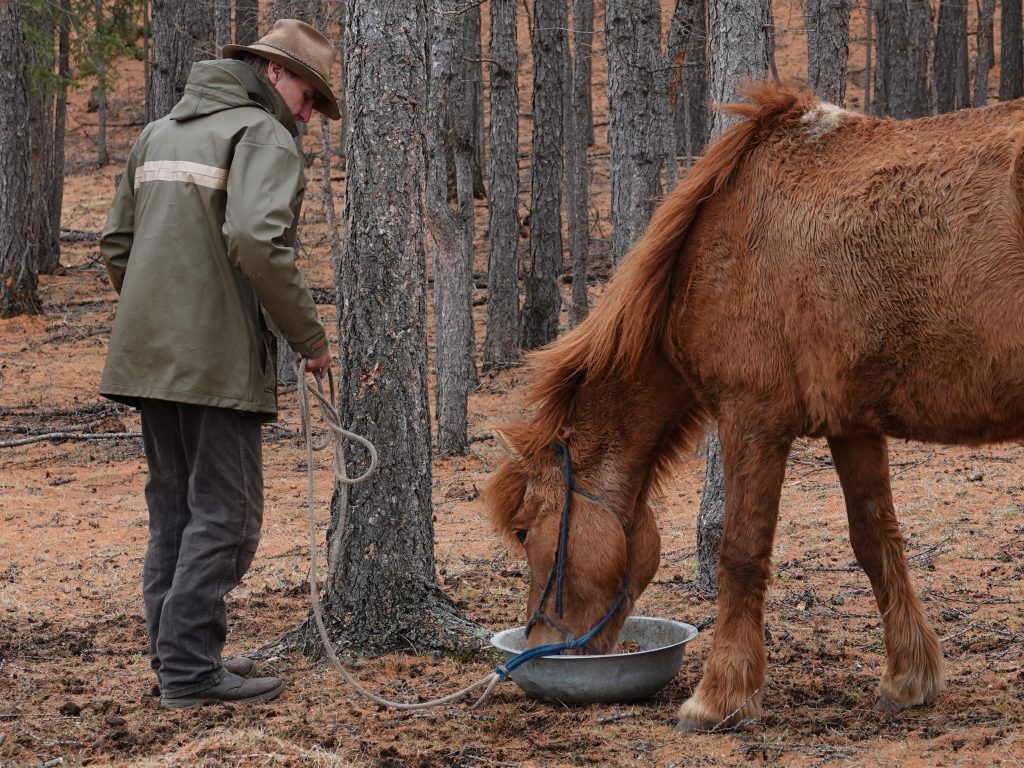
The final step, also perceived as “reward” by the treated horses, is de-worming. We mix the de-worming paste in a nice mush of oats, bran and water, and they gobble it all up with a good appetite. Only the ones who have had a calming-down shot, have to wait a bit until they get their de-wormer snack.
House Calls and Vet Visits in Winter Nights
Mongolian horses are in general of very good health, robust and resistant, and we have been very fortunate. In winter, when they feed on grain and dry hay, we have occasional incidents of mild colic, and in spring time when they transition to fresh grass, there may be occasions with mild inflammations and fever.
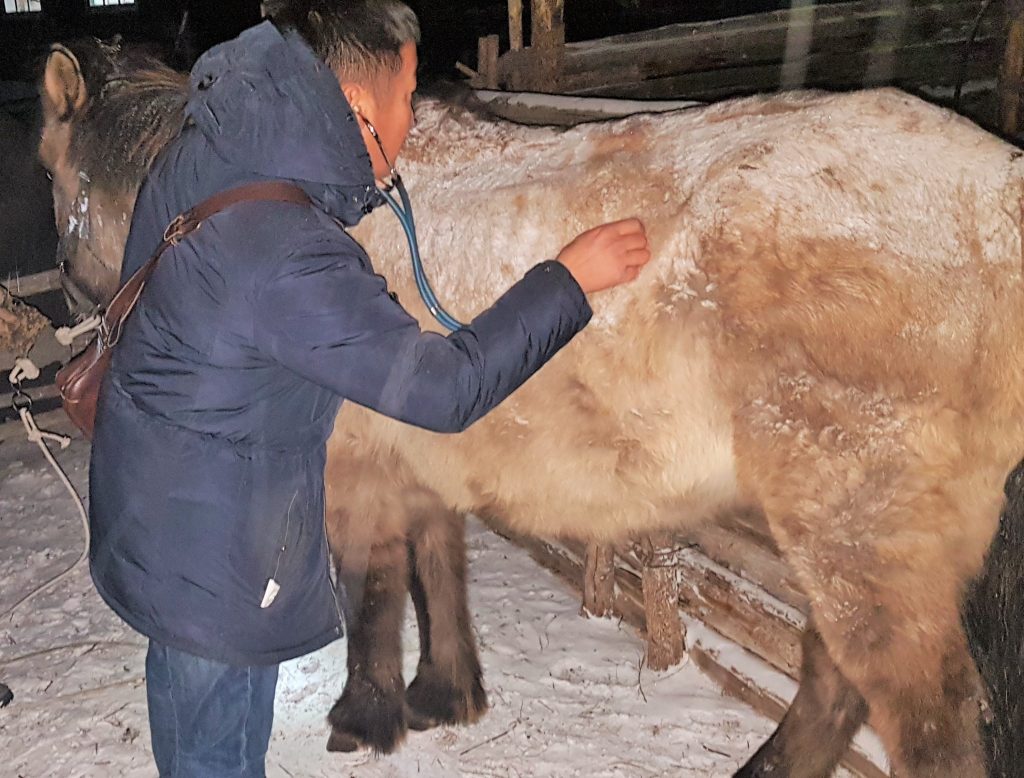
And so every winter, there are a few nights, where we take the vet up to the horses to check on them, give injections, or do other procedures if deemed necessary. There have been some injuries, bites or bruises or sores, and we have been amazed how fast and well the horses usually heal.
Their response to antibiotics is excellent, as they are not used to any such medicines, and in summer time when out on their mountain pastures, they supplement medicines with all the natural herbal remedies and it seems to aide very much in healing.
We have had small operations, to geld young stallions, and once for an injury. “Little Brother” one day showed up with a big L-shaped gash on his forehead. Covered by his forelock, we first did not see it, until he, atypically, vigorously rejected the bridle – for a good reason as we discovered.
The vet came and stitched the wound. And some weeks later, there was not even a trace of a scar – thanks to the skills of the vet and the self-healing powers of healthy Mongolian horses.
Equine First Aid Kit for Wilderness Treks
Likewise, on the trail, in serious back country, we have been fortunate to not have experienced any serious horse injuries. In the old days, when we were exploring the Khentii mountains by ourselves, with just our two Greys, and one packhorse mostly, we have taken rest days when one of our saddle horses hurt his leg a bit. And a contagious eye infection on one pack trip was taken care of with saline solution.
In these early years in Mongolia, we had horse injuries, and fatalities, from wolf attacks. My first horse in Mongolia, named Fish after the shape of his brand, and now a retired veteran with special privileges in access to hay, was lucky to survive several wolf attacks. He had a number of tears, L-shaped injuries on his neck that we disinfected and that healed well.
It was his love of taking naps, while other herd members moved on grazing, that probably exposed him a couple of times to mishaps like wolf attacks. Sadly though, we have lost two horses to wolves over the years, both in the area of their home valley, where during winter time wolf packs come through.
In more recent years, a swollen leg from a night time entanglement in a rope was one incident for which we took a long break to have the patient stand in a cool creek. A little pack horse was a bit colicky one night a few years ago, and we kept him moving, up-hill and down-hill, for a few hours until he felt better.
There are scratches and little cuts, from rocks, or perhaps from a hobble sometimes, and there are galls sometimes after a long day of trekking. Our equine first aid kit always has salves, tinctures and ointments to protect, disinfect and aide in healing. One of the pack horses will have it in his pack, and our packers always know who carries it in case it’s needed on the trail.
Ancient Heritage of Equine Dentistry in Mongolia
Speaking of horse care in Mongolia, it should be mentioned that equine dentistry was practiced already 3000 years ago in Mongolia. Referring to research findings (1) from Mongolia, published in 2018, an article in “The Horse” reports that as “herders began to use metal bits, they also developed a method for extracting these problematic teeth, similar to how most veterinary dentists would remove them today….In doing so, these early riders could control their horses in high-stress situations using a metal bit without potential behavioral or health complications, which could have had major implications for the ancient world.”(2)
Horses Fit and Ready for Expeditions
With the year-round care and supplemental feeding in addition to their natural grazing, our horses keep in shape for their expedition jobs. Check out our horseback riding tours:
10 Days Gorkhi Terelj National Park
8 Days Gorkhi Terelj National Park Autumn Ride
14 Days Wilderness Conservation Adventure
14 Days Khentii Mountains Expedition
———————————————————————————————————————————————————
(1) https://www.pnas.org/content/115/29/E6707.Origins of equine dentistry (2018). William Timothy Treal Taylor, Jamsranjav Bayarsaikhan, Tumurbaatar Tuvshinjargal, Scott Bender, Monica Tromp, Julia Clark, K. Bryce Lowry, Jean-Luc Houle, Dimitri Staszewski, Jocelyn Whitworth, William Fitzhugh, and Nicole Boivin. Proceedings of the National Academy of Sciences of the United States of America. PNAS July 17, 2018 115 (29) E6707-E6715; published ahead of print July 2, 2018 https://doi.org/10.1073/pnas.1721189115
(2) https://thehorse.com/159196/oldest-evidence-of-equine-dental-care-discovered-in-mongolia/
Here is the post as a flip book:


